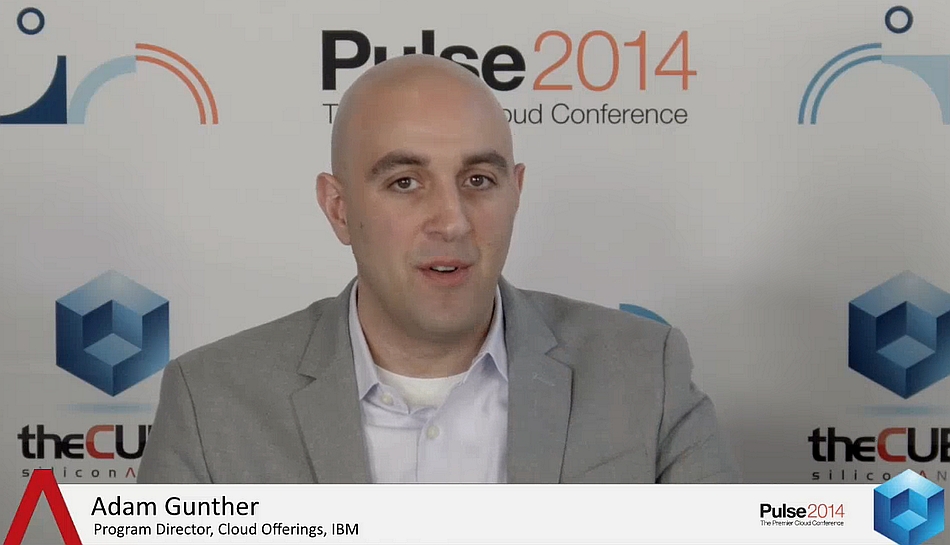 NEWS
NEWS
 NEWS
NEWS
 NEWS
NEWS
![]() Adam Gunther, Program Director of Cloud Offerings with IBM, accepted John Furrier and Dave Vellante’s invitation to appear in theCUBE, where they shared with the viewers the origin of BlueMix, the big news at the IBM Pulse 2014 Conference and the business side of cloud.
Adam Gunther, Program Director of Cloud Offerings with IBM, accepted John Furrier and Dave Vellante’s invitation to appear in theCUBE, where they shared with the viewers the origin of BlueMix, the big news at the IBM Pulse 2014 Conference and the business side of cloud.
Furrier began by reiterating that ”Cloud equals growth” and noted that about 70 percent of the attendees of the current IBM Pulse event are first-timers. “You are attracting some new talent to the show,” he said, mentioning the parallel Cloud Enabled Technologies and DevOps stream, “a hackathon meets party, with no strings attached,” a sort of a foray into the Bear Hug community.
Picking up on the IBM forecast of $7 billion dollars by 2015 in cloud revenue, Furrier asked Gunther to share the vision behind cloud operations and cloud offerings: “Give us the scoop on the infrastructure, scale and the tooling.”
“It comes from a simple starting point: developers are where innovation happens,” Gunther started. “It happens with a developer, sitting behind a desk somewhere, having his coffee and coming up with an idea. When you have a small idea like that, how do you iterate and turn it into business value?”
“How do you start and build from the systems that you have today and make it a more engaging experience? That’s where we really started with BlueMix,” explained Gunther. “We wanted to build a platform where developers could iterate rapidly, have a large variety of services, of runtimes of choice, to build on top of what’s out there today, to get at the backend data and then develop real value. That’s where the billion dollar ideas and the innovations come from.”
“The API economy it’s really where it’s at,” continued Gunther. “In forty years the new generation of developers will not even understand the concept of ‘installing software’.”
“How much of the WebSphere DNA is in the BlueMix?” asked Vellante.
“Conceptually, what we did with WebSphere 15 years ago for the web, was help the enterprise get from their backend systems into the web. What we’re doing now with the cloud is the same thing, taking them to the next generation and being able to extend and build on what you have today,” answered Gunther. “The systems that are there today are great systems and they do a lot good. You’re not just going to tear them down and throw them in the cloud. It’s really about hybrid and integration, about taking new services in the cloud and using them with systems on the backend to build a new engaging experience.”
“We are not just taking a bunch of IBM software and throwing it in the cloud as it is. When you hear about ‘IBM as a Service’ it means taking things from our knowledge and history, making sure it is ready for a cloud environment,” explained Gunther.
“Where do you think the blind spots are?” asked Vellante.
“Let me tell you what we’re doing to find our blind spot, because it’s more important,” offered Gunther. “IBM Design has been doing some great things, helping us think through ‘how do we develop software from a user perspective’ and ‘how do we connect with people’. This is one of the signature products where, with BlueMix, we are following the design process. We have a great team of designers working on it, plus sponsor clients (companies ranging from three people to large enterprises). We meet with them on a weekly basis and we playback our designs and our architecture. We hear their feedback and we understand what the blind spots are.”
“What is Database as a Service and why is it important?” asked Furrier, reading out a question received online.
“Like anything as a service, Database as a Service is database exposed through APIs, that I can call in the cloud very easily. I don’t have to set up a database or administer it, I don’t need to get a bunch of hardware and deploy it, and I don’t have to worry about how do I scale the database infrastructure,” explained Gunther. “The whole ‘as a Service’ model is ‘I just want to read/write to a database’.”
“Talk about the workload management aspect in context with open technology,” invited Furrier.
“It’s all about elasticity. People want to deploy things without thinking about it. That’s the beauty of PaaS and Cloud Foundry; we have the ability to do those type of things as we go down the road. We are really excited about Open Foundation and all the companies there. It has a good governance model and it’s been a great partnership with Pivotal and everyone so far,” said Gunther.
“What is your advice for the CIOs out there willing to hire new developers?” asked Furrier.
“I’ve been a Developer manager in the past and I hired engineers. It comes down to enthusiasm. Obviously they will have technical skills, but get someone that is enthusiastic, has a passion and wants to build things and experiment,” advised Gunther. “These developers will go into these platforms, look at a combinations of services and think of new things that no one has ever thought of. And that’s what people want, in order to innovate and move the business forward.”
THANK YOU